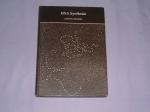|
This section contains 476 words (approx. 2 pages at 300 words per page) |

|
DNA, short for deoxyribonucleic acid, is a double-stranded, helical molecule that forms the molecular basis for heredity. For DNA replication (duplication) to occur, this molecule must first unwind, or "unzip," itself to allow the information-encoding bases to become accessible. The base pairing within DNA is of a complementary nature and, consequently, when the molecule unzips, due to the action of enzymes, two strands are temporarily produced, each of which acts as a template. A replication fork is first made--the DNA molecule separates at a small region and then the enzyme DNA polymerase adds complementary nucleotides to each side of the freshly separated strands. The DNA polymerase adds nucleotides only to one end of the DNA. As a result, one strand (the leading strand) is replicated continuously, while the other strand (the lagging strand) is replicated discontinuously, in short bursts. Each of these small sections is finally...
|
This section contains 476 words (approx. 2 pages at 300 words per page) |

|


